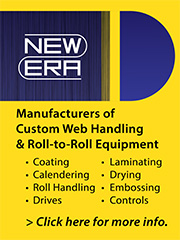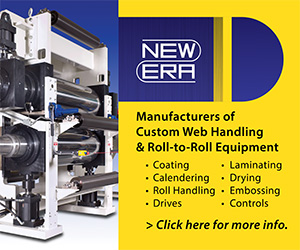Solvent-Free Lamination | Nordmeccanica Opens/Demos at New Permanent NA Home
- Published: June 11, 2015
By Tom Bezigian, PLC Technologies, PFFC Contributor
Nordmeccanica celebrated its new permanent location in Hauppauge, NY, with a grand opening and open 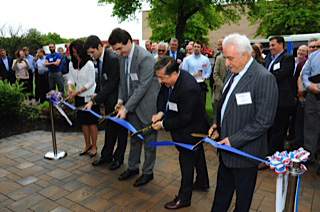 house on June 2, 2015. It truly was a grand affair, with 120 attendees from many different countries, technical presentations, a live machine demonstration, and in keeping with Italian style and tradition, food and wine. Nearly two-thirds of the attendees were converters who were very interested in witnessing the lamination of 5 micron (0.00020") aluminum foil, the first time such a feat has been done in North America according to Giancarlo Caimmi, commercial director of Nordmeccanica NA.
house on June 2, 2015. It truly was a grand affair, with 120 attendees from many different countries, technical presentations, a live machine demonstration, and in keeping with Italian style and tradition, food and wine. Nearly two-thirds of the attendees were converters who were very interested in witnessing the lamination of 5 micron (0.00020") aluminum foil, the first time such a feat has been done in North America according to Giancarlo Caimmi, commercial director of Nordmeccanica NA.
For those familiar with Nordmeccanica 's former office on Long Island, the new one is only about three miles away and is now their permanent North American headquarters office, showroom, and warehouse. Shown below is the official ribbon cutting ceremony, performed by Vicki Bakos, office manager; Alfredo Cerciello, financial director–Nordmeccanica Group; Vincenzo Cerciello, president–Nordmeccanica NA; Giancarlo Caimmi, commercial director–Nordmeccanica Group; and Antonio Cerciello, member of the board of Nordmeccanica Group. Suffice it to say, the event was fun, and done in Italian style and grandeur.
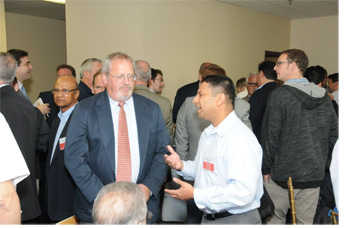 In a press release following the event, Nordmeccanica indicated that the 80 or so of the attendees were converters, with the remainder being suppliers, educational, consultants and industry association members representing the following companies: Admiral Packaging; AIMCAL; Ampac; Amerifilm; Ashland; Balcan Plastics; Berry Plastics; Bondex; Cadillac Products; CPP; Coim; Consolidated Packaging; Converting Quarterly; Custom Laminating; Dow Chemical; Emerald Packaging; Enercon Industries Corp.; FilmTech; First Quality; Flexo Transparent; Flexstar Packaging; Flexible Packaging Assn.; Flexographic Technical Assn.; Garlock Printing; Golden Eagle Extrusion; Griff Paper and Film; HBC Packaging; HB Fuller; Henkel Liofol; Hydro; Interflex Group; Inteplast; Kennametal; Jean Landry & Co.; Josh Packaging; LallyPack; LPS Industries; Multifilm; Pentaflex; Paper, Film & Foil Converter (PFFC); Poly Craft; Prolamina; Pro-Pals; Pure Pack Technologies; Robbie Mfg.; Ship & Shore; Starflex; Sterling; SunChemical; Ultra Flex; Vonco Products.
In a press release following the event, Nordmeccanica indicated that the 80 or so of the attendees were converters, with the remainder being suppliers, educational, consultants and industry association members representing the following companies: Admiral Packaging; AIMCAL; Ampac; Amerifilm; Ashland; Balcan Plastics; Berry Plastics; Bondex; Cadillac Products; CPP; Coim; Consolidated Packaging; Converting Quarterly; Custom Laminating; Dow Chemical; Emerald Packaging; Enercon Industries Corp.; FilmTech; First Quality; Flexo Transparent; Flexstar Packaging; Flexible Packaging Assn.; Flexographic Technical Assn.; Garlock Printing; Golden Eagle Extrusion; Griff Paper and Film; HBC Packaging; HB Fuller; Henkel Liofol; Hydro; Interflex Group; Inteplast; Kennametal; Jean Landry & Co.; Josh Packaging; LallyPack; LPS Industries; Multifilm; Pentaflex; Paper, Film & Foil Converter (PFFC); Poly Craft; Prolamina; Pro-Pals; Pure Pack Technologies; Robbie Mfg.; Ship & Shore; Starflex; Sterling; SunChemical; Ultra Flex; Vonco Products.
Background of the Host
Nordmeccanica claims to be the world's largest manufacturer of coating and laminating machinery with an estimated 70% global market share and more than 2,700 installations worldwide. Their product range covers an extensive number of technologies from the very compact family of Simplex laminators with manual unwinds and winders to the top range of fully-automatic, high-performance, coaters/laminators covering an extensive variety of commercial applications, such as water-based, solvent-based, 100% solids, hot melt, UV curable, EB curable, PSA, and heat seals, as well as metallizers for films and paper.
The firm manufactures coaters/laminators to produce two-ply structures all the way up to what is reported to be the first ever Quadruplex 4-ply adhesive laminator and a multi-layer (5-ply adhesive laminator), serving needs in coating, lamination, and metallization of paper, films, and foil for flexible packaging, industrial products, labels, pharmaceutical, and more. While the Simplex machine design is standardized, custom-configured machines are also offered with an extensive range of ancillaries that include a line of fully automatic, bi-directional, unwind, and rewind as well shaft-less and centre-surface technology.
Full Program
Various presentations provided history of the company along with technical information while providing ample time to network. Commercial director Caimmi served as master of ceremonies, sharing opening remarks and an overview of Nordmeccanica 's history, presence, and market share in North America, beginning in 1994. He reported that after several years of steady growth, and a market share of 20%-25% of adhesive laminating machines for flexible packaging in the USA, the company decided to open an office on Long Island, New York in September, 2001. Their plans were delayed because of the tragic events on September 11, but their market share in the USA has since grown to about 90%-95%, according to the company.
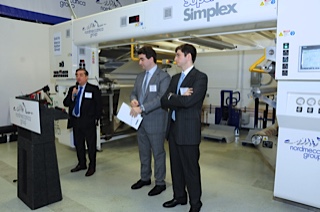 Caimmi reports, "The success of the company is based on top-quality equipment design and standardization of components. . . ." A demonstration was staged to prove his claim, noting the most common width sold in America is 59 in. (1.5m).
Caimmi reports, "The success of the company is based on top-quality equipment design and standardization of components. . . ." A demonstration was staged to prove his claim, noting the most common width sold in America is 59 in. (1.5m).
In my opinion, the introduction of an innovative product line for short runs was an ingenious strategy, as most of the orders in the industry today are indeed short to medium in length, and the company seemed to be ahead of the curve, so to speak, in 1994 when it entered the US market. With the advent of new technology, such as the Indigo 20000 digital printing press for roll to roll printing of flexible webs, run length and lead times have been shortened dramatically, and it seems to be the norm versus the exception with each passing day.
Caimmi observes that with the introduction of the Simplex in 1992, the company has since sold more than 1,000 Simplex machines. He expresses gratitude and gives credit to the company's "customers for incredible support."
Technical Presentations
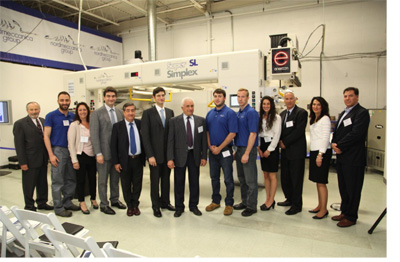 President Vincenzo Cerciello opened the sessions with a presentation on barrier webs, various structures commonly found, applications, as well as typical adhesives used in the industry. He reiterated the company strategy to provide simpler, yet high-quality machines with smaller footprints that reduce source (i.e., waste) and are environmentally-friendly (i.e., energy efficient). With strong supplier as well as industry association support, the company has come to understand the needs of the market. He indicated that both foil usage and flexible packaging in general are growing at a rate of 5% annually. This growth, coupled with ever-changing package shapes and sizes require constant machine development.
President Vincenzo Cerciello opened the sessions with a presentation on barrier webs, various structures commonly found, applications, as well as typical adhesives used in the industry. He reiterated the company strategy to provide simpler, yet high-quality machines with smaller footprints that reduce source (i.e., waste) and are environmentally-friendly (i.e., energy efficient). With strong supplier as well as industry association support, the company has come to understand the needs of the market. He indicated that both foil usage and flexible packaging in general are growing at a rate of 5% annually. This growth, coupled with ever-changing package shapes and sizes require constant machine development.
With early experience in 3-ply lamination and patterned metallization without the use of de-metallizing (made possible with the acquisition of Galileo vacuum metallizers three years ago), Cerciello emphasized the firm's investment of 3%–5% of sales in R&D annually to allow the point of the day's demonstration—to laminate a 5μ aluminum foil (made by Hydro Foil in Düsseldorf).
A brief overview by financial director Alfredo Cerciello highlighted the company's size, strength, and geographical breadth, followed by an excellent hands-on presentation by Dr. Duncan Darby, associate professor in the Food Nutrition and Packaging Sciences Dept. at Clemson University, Clemson, SC, on the properties and converting of aluminum foils. He observed US companies are behind the global market when it comes to foil converting. He indicated that Alusuisse, one of his previous employers, was converting 7μ aluminum foil years ago, well before the US, at very high rates of speed. Dr. Darby suggests that the US must now again catch up with Europe to begin converting lighter weight foil, which will require a new generation of equipment.
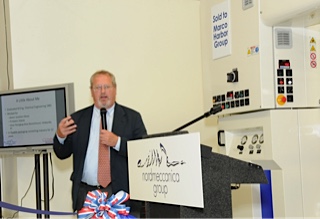 Dr. Darby reviewed various foil grades, indicating there is more than Alloy 1145-0, a dead-soft, A-wettability general purpose foil, and that the right foil on the right machine is required to make good quality product. For example, foil temper matters, meaning dead-soft foil can have A-wettability foil, but harder foils require residual rolling oils and must be treated properly on-line. Also, foil is heavier than film but much less extensible, so perfect web tension is an absolute requirement, meaning driven unwinds, smooth, aligned, free-turning idlers, and perfect alignment are required to convert lightweight aluminum foil without wrinkles, pinholes, or web breaks. For further information, contact Dr. Darby at ddarby@clemson.edu.
Dr. Darby reviewed various foil grades, indicating there is more than Alloy 1145-0, a dead-soft, A-wettability general purpose foil, and that the right foil on the right machine is required to make good quality product. For example, foil temper matters, meaning dead-soft foil can have A-wettability foil, but harder foils require residual rolling oils and must be treated properly on-line. Also, foil is heavier than film but much less extensible, so perfect web tension is an absolute requirement, meaning driven unwinds, smooth, aligned, free-turning idlers, and perfect alignment are required to convert lightweight aluminum foil without wrinkles, pinholes, or web breaks. For further information, contact Dr. Darby at ddarby@clemson.edu.
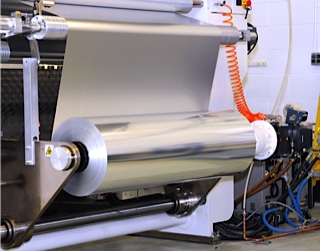 Last, but not least, Giancarlo Caimmi, gave an excellent presentation on equipment design for the lamination of flexible barrier webs, complete with world-class graphics. Caimmi reviewed the different systems and configurations required to produce laminations using water-based, solvent-based, and solvent-free laminations. He dwelled on the details of machine design, such as regenerative motors and their necessity on the foil unwind station, speed control on a 4-roll solvent-free applicator station, chilling the web at precise locations, combination solvent-based/solvent-free laminators to produce triplex structures, and much, much more.
Last, but not least, Giancarlo Caimmi, gave an excellent presentation on equipment design for the lamination of flexible barrier webs, complete with world-class graphics. Caimmi reviewed the different systems and configurations required to produce laminations using water-based, solvent-based, and solvent-free laminations. He dwelled on the details of machine design, such as regenerative motors and their necessity on the foil unwind station, speed control on a 4-roll solvent-free applicator station, chilling the web at precise locations, combination solvent-based/solvent-free laminators to produce triplex structures, and much, much more.
The Demonstration
While all of this was fun, interesting and informative, the "real meat and potatoes" of the day was in the machine demonstration. The demonstration involved a lamination of a 5μ aluminum foil, supplied by Hydro Aluminium (Düsseldorf, Germany), to a printed oriented polyester (OPET) film supplied by Ultra Flex Packaging (Brooklyn, NY) with an undisclosed solvent-free adhesive on a completely standard 59-in. (1.5 m) Super Simplex line.
Web handling is the key to laminating lightweight foils. I've observed thousands of winders in my career, and without reservation, in my opinion the Super Simplex unwind was ROCK SOLID. This was the key to the whole demonstration being successful. All of the following contribute to a winning formula: unwind stand size and rigidity; unwind motor size and control; idler roll design, balance and fabrication; 4-roll laminator design and speed control; line tension control; process conditions; and speed ramp-up protocol to efficiently produce a new structure heretofore unmade in the US—namely that containing a 5μ aluminum foil. To put this in perspective, 5μ is 1/10 (one-tenth) the thickness of a human hair. The fascinating thing is that all this comes in a standard line, at standard pricing, versus custom-machinery pricing.
Both the first pass of foil to OPET, and the second pass lamination of Pass 1 to OPET film, were done first at 600 ft/min (182 m/min), which is the speed required by the solvent-free adhesive lamination of barrier webs in general—and with thin film in particular—to be free of voids due to out-gassing from the adhesive curing process, and then at 1,000 ft/min (304 m/min) to demonstrate the capability of the machine.
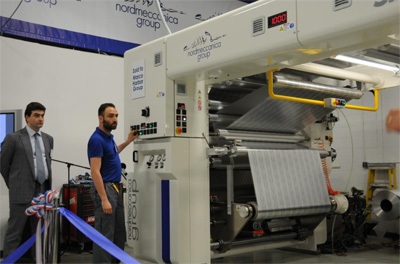 The ramifications of using thinner foils are obvious, namely lower raw material and shipping costs, and reduced environmental burden. Reducing the foil component from 7μ to 5μ reduces the foil component weight by 28%, which should result in a 10% cost reduction. As Dr. Darby mentioned in his presentation, American converters are more or less stuck in the past with notions about aluminum foil, which translates to reduced efficiency and productivity and increased cost, putting US manufacturers at a competitive disadvantage.
The ramifications of using thinner foils are obvious, namely lower raw material and shipping costs, and reduced environmental burden. Reducing the foil component from 7μ to 5μ reduces the foil component weight by 28%, which should result in a 10% cost reduction. As Dr. Darby mentioned in his presentation, American converters are more or less stuck in the past with notions about aluminum foil, which translates to reduced efficiency and productivity and increased cost, putting US manufacturers at a competitive disadvantage.
Unfortunately, little information was provided on the foil, film, and adhesive. However, information from Hydro Aluminium's website indicates that they introduced the 5μ aluminum foil in May of 2014. One year later, it was introduced into the US by Nordmeccanica. Likewise, little information was provided about the adhesive, other than it was a two-part solvent-free quick-cure adhesive, such as Ashland Chemical's 9500/9240 two-part system. The adhesive possessed enough "green-strength" to allow a second pass of the foil/OPET lamination immediately to go through a second lamination step without separating. Adhesion improved steadily over the next few days, and within three days it proved to be inseparable, as shown below. This "casual" test, or observation, without the use of measuring devices showed that three days was required for the solventless adhesive system to cure and provide a destructive bond between layers.
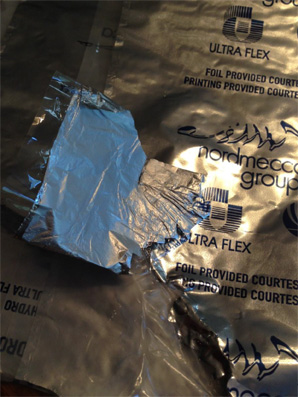 Networking with Attendees
Networking with Attendees
While at the event I had the opportunity to interview Dale Ince, VP at FLEXSTAR Packaging near Vancouver, BC, Canada. FLEXSTAR manufactures both mono-layer and coextruded films for internal and external uses, with the majority of their films used in food industries and formulated for specific end-use applications. FLEXSTAR also produces laminations and coated webs, such as the ones demonstrated at this event using solvent, solventless, and water-based platforms. They have three Nordmeccanica machines, including a Super Simplex and two Super Combi 3000s, which are used to produce coffee pouches, patterned cold seal products, and registered matt finish for medical and confectionary applications. Ince attributes much of their success to the quality, productivity, and efficiency of their Nordmeccanica equipment.
Lastly, I spoke with Steven Lekan, sales manager, Nordmeccanica NA, who said: "Our grand opening was a very well attended event. Through the impressive demonstration of technology featured during the technical section. . . and lamination demonstration, [it] will for sure help the attendees improve their internal performances especially in foil lamination."
All in all, the machine demonstration was very impressive, the suppliers were very knowledgeable, and present customers were quite happy with their equipment. In my opinion, the operative word to remember about the machine is rock-solid. Well, it might be two words, but you get the idea.



